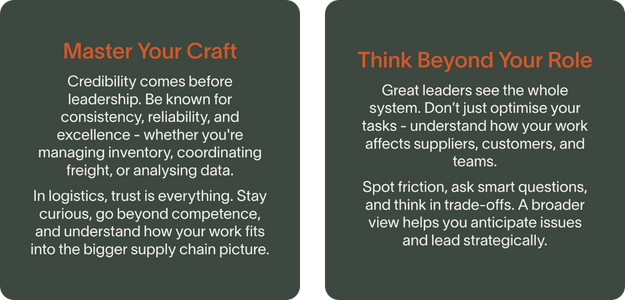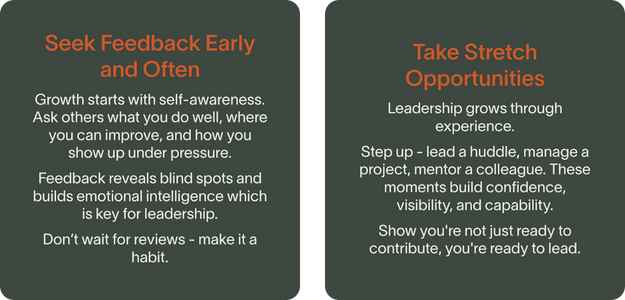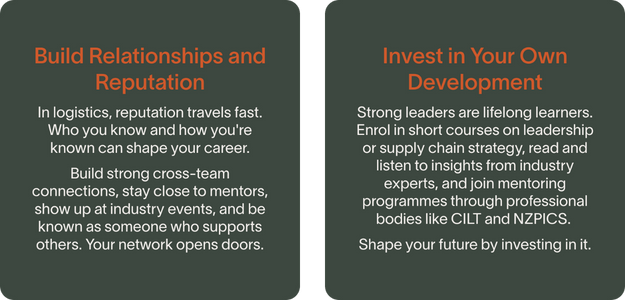Level 4
57 Fort Street
Auckland Central
Auckland 1010

By: Michelle Elsley, Partner - Supply Chain & Operations
Consider this scenario: A mid-sized logistics firm farewells two senior operations managers within a few months. The day-to-day continues, but the ripple effects are felt - slower decisions, less clarity, and a team looking for direction. It’s a timely reminder: having the right people ready to step up is just as critical as keeping the freight moving.
In supply chain conversations, we tend to focus on the visible levers: freight volumes, port congestion, fuel costs, and tech upgrades. These are the metrics we can measure, optimise, and report on. But there’s another flow that’s just as critical yet often overlooked: the flow of people into leadership roles. This invisible infrastructure determines whether logistics organisations thrive, adapt, or fall behind. And unlike cargo delays or software outages, leadership gaps don’t show up on dashboards, until it’s too late.
As someone who recruits across New Zealand’s logistics and operations sector, I see the same pattern play out time and again. Companies invest heavily in assets, contracts, and systems, but treat leadership development as something that will “take care of itself.” It doesn’t. In a market as tight-knit and talent-constrained as ours, the next generation of leaders won’t simply emerge - they need to be identified, nurtured, and deliberately built.
This article is for both mentors and mentees navigating the logistics industry. Whether you're guiding others or preparing to lead, understanding how to bridge the gap to leadership is essential - not just for individual growth, but for the resilience and continuity of the entire sector.
For many professionals working in logistics, the idea of stepping into leadership feels like a natural progression. You’ve built deep expertise in your role (whether that’s coordinating freight movements, managing inventory flows, or streamlining transport operations), and you’ve earned a reputation for delivering results. But once you’ve mastered the mechanics of your job, a new question inevitably surfaces: “Where do I go from here?”
But the transition from operator to leader is more than a promotion or a new title. It’s a fundamental shift in how you think, act, and measure success. It’s not just about doing more… it’s about doing differently.
The most challenging part of stepping into leadership is moving from doing the work yourself to enabling others to do it well. In logistics, where precision and control are often critical, this shift can feel uncomfortable. You’re no longer judged by your personal output, but by how effectively your team delivers. That means:
This is more than a skill change, it’s an identity shift. You move from being the expert to being the enabler. And unlike a forklift licence or ERP training, there’s no manual for this transition. And many promising professionals stall at this stage - not because they lack ability, but because they hit invisible walls. Common barriers include:
Leadership isn’t a destination - it’s a discipline. And in logistics, where the pace is fast and the pressure is real, it’s easy to stay in the comfort zone of execution. If you’re serious about stepping into leadership, you need to start building the habits, mindset, and visibility that will get you there.
Here are six practical, high-impact steps to help you grow into leadership, no matter where you are in your career:



For those already in leadership roles, this conversation should cut just as deep. Many of you were promoted because you excelled operationally… but have you stopped to ask how you’re preparing the next wave?
Too often, succession is left to chance. Leadership pipelines are only considered when a vacancy forces the issue, and by then, it’s often too late. In New Zealand, this risk is particularly acute. Thousands of Kiwi business owners and senior professionals are nearing retirement, yet most lack a clear succession plan.* In logistics, where operational continuity is critical, this creates a silent vulnerability.
The Hanga-Aro-Rau Workforce Development Report highlights that the logistics sector is facing a significant talent shortage, compounded by an ageing workforce and limited branding as a long-term career destination.** The sector is struggling to attract and retain talent at scale, and without deliberate leadership development, the gap will only widen.
This isn’t just a workforce issue, it’s a strategic one. If senior leaders don’t actively invest in mentoring and succession, organisations risk losing institutional knowledge, culture, and capability in one swift exit. The responsibility lies with today’s leaders to change this. That means:
These initiatives are vital but they need champions. Senior leaders must not only support them but actively participate. Your legacy won’t be defined by the systems you implemented or the contracts you won. It will be defined by the people you lifted, the culture you shaped, and the leaders you left behind.
Whether you're a seasoned leader or an emerging one, the time to invest in people is now. Start the conversation. Build the bridge. Shape the future.
* https://www.times.co.nz/business/new-zealand-faces-succession-planning-crunch/